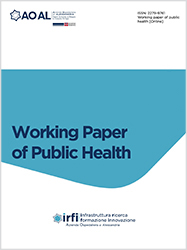Prevalence of Acinetobacter baumannii infections during the SARS-CoV-2 pandemic in the SS. Antonio e Biagio e Cesare Arrigo Hospital of Alessandria

Accepted: 29 November 2023
All claims expressed in this article are solely those of the authors and do not necessarily represent those of their affiliated organizations, or those of the publisher, the editors and the reviewers. Any product that may be evaluated in this article or claim that may be made by its manufacturer is not guaranteed or endorsed by the publisher.
Aims: 2020 was marked by the emergence of SARS-CoV-2. The dramatic growth of hospitalized patients infected by SARS-CoV-2 may have led to an increase in secondary infections and/or healthcare-associated infections. It is evident that the need for high-spectrum antibiotic therapy in patients with severe illness contributed to the spread of Multi Drug Resistant (MDR) bacteria. The aim of this work was to evaluate the trend of Acinetobacter baumannii infections during the SARS-CoV-2 pandemic in Santi Antonio e Biagio and Cesare Arrigo Hospital in Alessandria. Materials and Methods: all the isolates of A. baumannii and positive swabs for SARS-CoV-2 detected in hospitalized patients were included in the analysis. Results: between November 2020 and March 2021, an increase of the A. baumannii isolation occurred compared to the period November 2019 - March 2020, especially in the Intensive Care Units. A reduction of the A. baumannii isolation from November 2021 to March 2022 was observed. Conclusions: the differences observed are probably due to the administration of vaccines and consequently to the lower severity of COVID-19 cliniacl pictures.
Ayoub Moubareck C, Hammoudi Halat D. Insights into Acinetobacter baumannii: A Review of Microbiological, Virulence, and Resistance Traits in a Threatening Nosocomial Pathogen. Antibiotics (Basel). 2020;9:119. DOI: https://doi.org/10.3390/antibiotics9030119
Howard A, O'Donoghue M, Feeney A, Sleator RD. Acinetobacter baumannii: an emerging opportunistic pathogen. Virulence. 2012;3:243-50. DOI: https://doi.org/10.4161/viru.19700
Harding C., Hennon S., Feldman M. Uncovering the mechanisms of Acinetobacter baumannii virulence. Nat Rev Microbiol. 2018;16:91-102. DOI: https://doi.org/10.1038/nrmicro.2017.148
Gedefie A, Demsis W, Ashagrie M, et al. Acinetobacter baumannii Biofilm Formation and Its Role in Disease Pathogenesis: A Review. Infect Drug Resist. 2021;14:3711-9. DOI: https://doi.org/10.2147/IDR.S332051
García-Garmendia JL, Ortiz-Leyba C, Garnacho-Montero J, et al. Risk factors for Acinetobacter baumannii nosocomial bacteremia in critically ill patients: a cohort study. Clin Infect Dis. 2001;33:939-46. DOI: https://doi.org/10.1086/322584
Chakravarty B. Genetic mechanisms of antibiotic resistance and virulence in Acinetobacter baumannii: background, challenges and future prospects. Mol Biol Rep. 2020;47:4037-46. DOI: https://doi.org/10.1007/s11033-020-05389-4
Cucinotta D, Vanelli M. WHO Declares COVID-19 a Pandemic. Acta Biomed. 2020;91:157-60.
Abdela SG, Liesenborghs L, Tadese F, et al. Antibiotic Overuse for COVID-19: Are We Adding Insult to Injury? Am J Trop Med Hyg. 2021;105:1519-20. DOI: https://doi.org/10.4269/ajtmh.21-0603
Jeon K, Jeong S, Lee N, et al. Impact of COVID-19 on Antimicrobial Consumption and Spread of Multidrug-Resistance in Bacterial Infections. Antibiotics (Basel). 2022;11:535. DOI: https://doi.org/10.3390/antibiotics11040535
Arabi YM, Myatra SN, Lobo SM. Surging ICU during COVID-19 pandemic: an overview. Curr Opin Crit Care. 2022;28:638-44. DOI: https://doi.org/10.1097/MCC.0000000000001001
Baccolini V, Migliara G, Isonne C, et al. The impact of the COVID-19 pandemic on healthcare-associated infections in intensive care unit patients: a retrospective cohort study. Antimicrob Resist Infect Control. 2021;10:87. DOI: https://doi.org/10.1186/s13756-021-00959-y
Alenazi TA, Shaman MSB, Suliman DM, et al. The Impact of Multidrug-Resistant Acinetobacter baumannii Infection in Critically Ill Patients with or without COVID-19 Infection. Healthcare (Basel). 2023;11:487. DOI: https://doi.org/10.3390/healthcare11040487
Dubois D, Grare M, Prere MF, et al. Performances of the Vitek MS matrix-assisted laser desorption ionization-time of flight mass spectrometry system for rapid identification of bacteria in routine clinical microbiology. J Clin Microbiol. 2012;50:2568-76. DOI: https://doi.org/10.1128/JCM.00343-12
Ling TK, Tam PC, Liu ZK, Cheng AF. Evaluation of VITEK 2 rapid identification and susceptibility testing system against gram-negative clinical isolates. J Clin Microbiol. 2001;39:2964-6. DOI: https://doi.org/10.1128/JCM.39.8.2964-2966.2001
Ligozzi M, Bernini C, Bonora MG, et al. Evaluation of the VITEK 2 system for identification and antimicrobial susceptibility testing of medically relevant gram-positive cocci. J Clin Microbiol. 2002;40:1681-6. DOI: https://doi.org/10.1128/JCM.40.5.1681-1686.2002
Copyright (c) 2024 Rebecca Bovo, Christian Leli, Annalisa Roveta, Serena Penpa, Antonio Maconi, Andrea Rocchetti

This work is licensed under a Creative Commons Attribution-NonCommercial 4.0 International License.
PAGEPress has chosen to apply the Creative Commons Attribution NonCommercial 4.0 International License (CC BY-NC 4.0) to all manuscripts to be published.

 https://doi.org/10.4081/wpph.2023.9794
https://doi.org/10.4081/wpph.2023.9794




